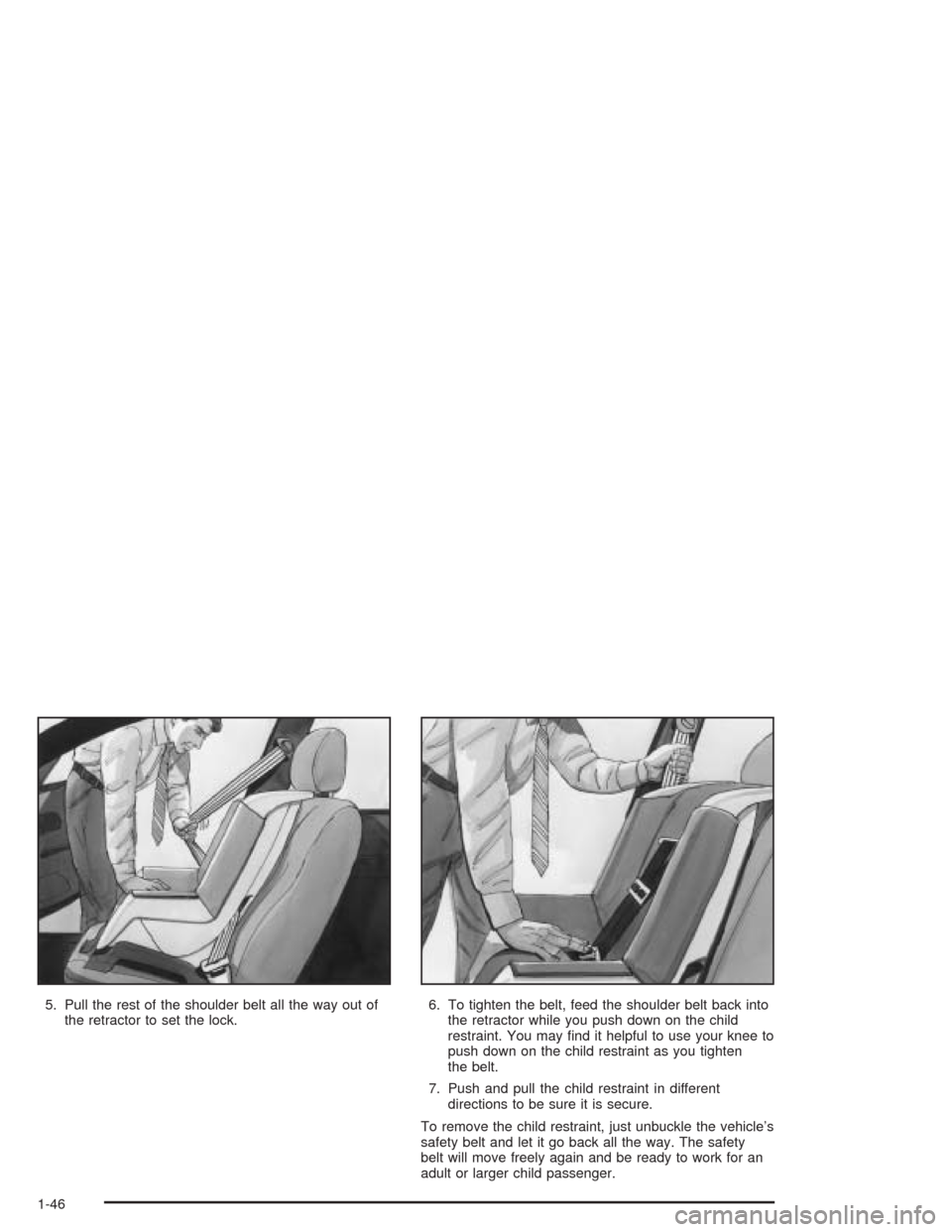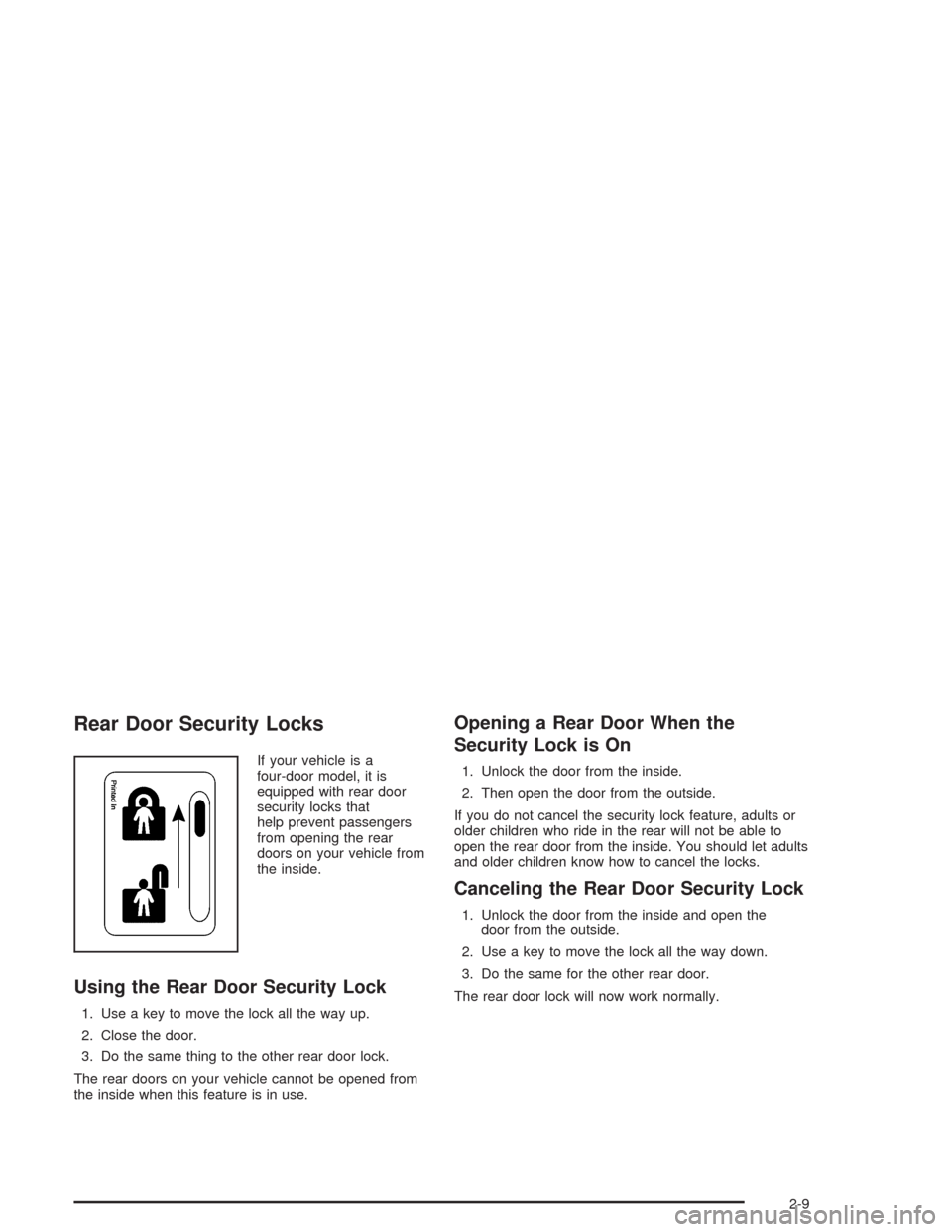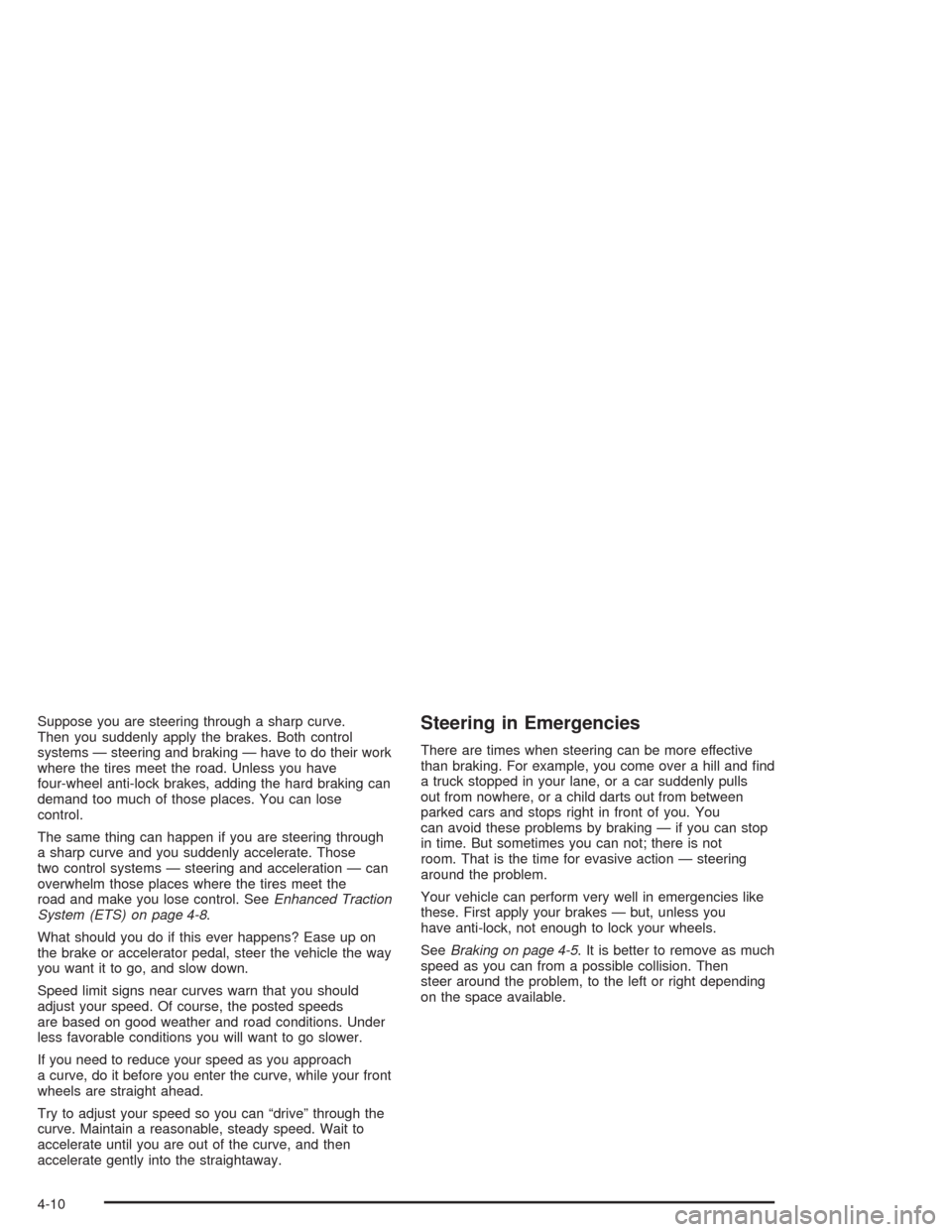2004 CHEVROLET CAVALIER child lock
[x] Cancel search: child lockPage 1 of 354

Seats and Restraint Systems........................... 1-1
Front Seats
............................................... 1-2
Rear Seats
............................................... 1-7
Safety Belts
.............................................. 1-8
Child Restraints
.......................................1-29
Air Bag Systems
......................................1-47
Restraint System Check
............................1-56
Features and Controls..................................... 2-1
Keys
........................................................ 2-2
Doors and Locks
....................................... 2-7
Windows
.................................................2-12
Theft-Deterrent Systems
............................2-14
Starting and Operating Your Vehicle
...........2-16
Mirrors
....................................................2-30
OnStar
®System
......................................2-32
Storage Areas
.........................................2-33
Sunroof
..................................................2-34
Instrument Panel............................................. 3-1
Instrument Panel Overview
.......................... 3-2
Climate Controls
......................................3-16
Warning Lights, Gages, and Indicators
........3-20
Audio System(s)
.......................................3-35Driving Your Vehicle....................................... 4-1
Your Driving, the Road, and Your Vehicle
..... 4-2
Towing
...................................................4-29
Service and Appearance Care.......................... 5-1
Service
..................................................... 5-3
Fuel
......................................................... 5-4
Checking Things Under the Hood
...............5-10
Bulb Replacement
....................................5-41
Windshield Wiper Blade Replacement
.........5-45
Tires
......................................................5-46
Appearance Care
.....................................5-72
Vehicle Identi�cation
.................................5-79
Electrical System
......................................5-80
Capacities and Speci�cations
.....................5-85
Normal Maintenance Replacement Parts
......5-86
Maintenance Schedule..................................... 6-1
Maintenance Schedule
................................ 6-2
Customer Assistance and Information.............. 7-1
Customer Assistance and Information
........... 7-2
Reporting Safety Defects
...........................7-10
Index.................................................................1
2004 Chevrolet Cavalier Owner ManualM
Page 28 of 354

Safety Belt Use During Pregnancy
Safety belts work for everyone, including pregnant
women. Like all occupants, they are more likely to be
seriously injured if they don’t wear safety belts.
A pregnant woman should wear a lap-shoulder belt, and
the lap portion should be worn as low as possible,
below the rounding, throughout the pregnancy.The best way to protect the fetus is to protect the
mother. When a safety belt is worn properly, it’s more
likely that the fetus won’t be hurt in a crash. For
pregnant women, as for anyone, the key to making
safety belts effective is wearing them properly.
Right Front Passenger Position
To learn how to wear the right front passenger’s safety
belt properly, seeDriver Position on page 1-14.
The right front passenger’s safety belt works the same
way as the driver’s safety belt – except for one thing.
If you ever pull the shoulder portion of the belt out all the
way, you will engage the child restraint locking feature.
If this happens, just let the belt go back all the way
and start again.
1-22
Page 52 of 354

5. Pull the rest of the shoulder belt all the way out of
the retractor to set the lock.6. To tighten the belt, feed the shoulder belt back into
the retractor while you push down on the child
restraint. You may �nd it helpful to use your knee to
push down on the child restraint as you tighten
the belt.
7. Push and pull the child restraint in different
directions to be sure it is secure.
To remove the child restraint, just unbuckle the vehicle’s
safety belt and let it go back all the way. The safety
belt will move freely again and be ready to work for an
adult or larger child passenger.
1-46
Page 71 of 354

Resynchronization
Your remote keyless entry system is equipped with a
security system that prevents anyone from recording and
playing back your signal. The transmitter does not
send the same signal twice to the receiver. The receiver
will not respond to a signal that has been sent to it
more than once.
Normally, the transmitter and receiver resynchronize
automatically. However, under certain circumstances,
manual resynchronization may be required.
To resynchronize your transmitter and receiver, follow
these directions:
1. Stand close to your vehicle.
2. Press and hold the LOCK and UNLOCK buttons on
the transmitter at the same time.
3. Hold the buttons for at least 10 seconds. During this
time, the doors should lock and unlock once. This
con�rms the resynchronization. If the doors do
not lock and unlock, see your dealer for service.
Doors and Locks
Door Locks
{CAUTION:
Unlocked doors can be dangerous.
Passengers — especially children — can
easily open the doors and fall out of a
moving vehicle. When a door is locked, the
handle will not open it. You increase the
chance of being thrown out of the vehicle
in a crash if the doors are not locked. So,
wear safety belts properly and lock the
doors whenever you drive.
Young children who get into unlocked
vehicles may be unable to get out. A child
can be overcome by extreme heat and can
suffer permanent injuries or even death
from heat stroke. Always lock your vehicle
whenever you leave it.
Outsiders can easily enter through an
unlocked door when you slow down or
stop your vehicle. Locking your doors can
help prevent this from happening.
2-7
Page 73 of 354

Rear Door Security Locks
If your vehicle is a
four-door model, it is
equipped with rear door
security locks that
help prevent passengers
from opening the rear
doors on your vehicle from
the inside.
Using the Rear Door Security Lock
1. Use a key to move the lock all the way up.
2. Close the door.
3. Do the same thing to the other rear door lock.
The rear doors on your vehicle cannot be opened from
the inside when this feature is in use.
Opening a Rear Door When the
Security Lock is On
1. Unlock the door from the inside.
2. Then open the door from the outside.
If you do not cancel the security lock feature, adults or
older children who ride in the rear will not be able to
open the rear door from the inside. You should let adults
and older children know how to cancel the locks.
Canceling the Rear Door Security Lock
1. Unlock the door from the inside and open the
door from the outside.
2. Use a key to move the lock all the way down.
3. Do the same for the other rear door.
The rear door lock will now work normally.
2-9
Page 176 of 354

Suppose you are steering through a sharp curve.
Then you suddenly apply the brakes. Both control
systems — steering and braking — have to do their work
where the tires meet the road. Unless you have
four-wheel anti-lock brakes, adding the hard braking can
demand too much of those places. You can lose
control.
The same thing can happen if you are steering through
a sharp curve and you suddenly accelerate. Those
two control systems — steering and acceleration — can
overwhelm those places where the tires meet the
road and make you lose control. SeeEnhanced Traction
System (ETS) on page 4-8.
What should you do if this ever happens? Ease up on
the brake or accelerator pedal, steer the vehicle the way
you want it to go, and slow down.
Speed limit signs near curves warn that you should
adjust your speed. Of course, the posted speeds
are based on good weather and road conditions. Under
less favorable conditions you will want to go slower.
If you need to reduce your speed as you approach
a curve, do it before you enter the curve, while your front
wheels are straight ahead.
Try to adjust your speed so you can “drive” through the
curve. Maintain a reasonable, steady speed. Wait to
accelerate until you are out of the curve, and then
accelerate gently into the straightaway.Steering in Emergencies
There are times when steering can be more effective
than braking. For example, you come over a hill and �nd
a truck stopped in your lane, or a car suddenly pulls
out from nowhere, or a child darts out from between
parked cars and stops right in front of you. You
can avoid these problems by braking — if you can stop
in time. But sometimes you can not; there is not
room. That is the time for evasive action — steering
around the problem.
Your vehicle can perform very well in emergencies like
these. First apply your brakes — but, unless you
have anti-lock, not enough to lock your wheels.
SeeBraking on page 4-5. It is better to remove as much
speed as you can from a possible collision. Then
steer around the problem, to the left or right depending
on the space available.
4-10
Page 345 of 354

H
Hazard Warning Flashers................................... 3-4
Head Restraints............................................... 1-5
Headlamp High/Low-Beam Changer.................... 3-7
Headlamp Wiring............................................5-80
Headlamps....................................................5-41
Bulb Replacement.......................................5-41
Front Turn Signal and Parking Lamps.............5-43
Halogen Bulbs............................................5-41
Highway Hypnosis...........................................4-22
Hill and Mountain Roads..................................4-22
Hitches..........................................................4-40
Hood
Checking Things Under................................5-10
Release.....................................................5-10
Horn............................................................... 3-5
How the System Alarm is Activated...................2-14
How to Add Coolant to the Coolant
Surge Tank.................................................5-27
How to Check................................................5-54
How to Check and Add Fluid............................5-20
How to Check Power Steering Fluid..................5-31
How to Detect a Tamper Condition....................2-15
How to Inspect the Engine Air Cleaner/Filter.......5-18
How to Turn Off the System Alarm....................2-15
How to Use This Manual...................................... ii
How to Wear Safety Belts Properly...................1-13Hydraulic Clutch.............................................5-19
Hydraulic Clutch System Check........................6-19
Hydroplaning..................................................4-18
I
If No Steam Is Coming From Your Engine..........5-24
If Steam Is Coming From Your Engine...............5-23
If the Light Is Flashing.....................................3-30
If the Light Is on Steady..................................3-31
If You Are Caught in a Blizzard.........................4-26
If You Are Stuck in Sand, Mud, Ice or Snow.......4-28
If You Do Decide To Pull A Trailer.....................4-38
Ignition Positions.............................................2-16
Ignition Transaxle Lock Check..........................6-21
Infants and Young Children, Restraints...............1-31
In�ation - Tire Pressure...................................5-53
Inspection
Brake System.............................................6-24
Caliper/Knuckle Maintenance.........................6-24
Engine Cooling System................................6-23
Exhaust System..........................................6-23
Fuel System...............................................6-23
Part C - Periodic Maintenance.......................6-23
Steering, Suspension and Front Drive Axle
Boot and Seal.........................................6-23
Throttle System...........................................6-23
7
Page 346 of 354

Instrument Panel
Cluster.......................................................3-21
Overview..................................................... 3-2
Instrument Panel Brightness.............................3-14
Instrument Panel Fuse Block............................5-82
Interior Lamps................................................3-14
J
Jump Starting.................................................5-36
K
Key Lock Cylinders Service..............................6-19
Key Release Button (Manual Transaxle).............2-18
Keyless Entry System....................................... 2-3
Keys............................................................... 2-2
L
Lamps
Exterior......................................................3-11
Interior.......................................................3-14
Lamps On Reminder.......................................3-12
Lap-Shoulder Belt...................................1-14, 1-23LATCH System
Child Restraints...........................................1-40
Securing a Child Restraint Designed for the
LATCH System........................................1-42
Latches, Seatback............................................ 1-6
Leaving Your Vehicle.......................................2-10
Leaving Your Vehicle With the Engine
Running.....................................................2-26
Light
Air Bag Readiness.......................................3-23
Anti-Lock Brake System Warning...................3-26
Brake System Warning.................................3-25
Charging System.........................................3-24
Check Gages Warning.................................3-33
Enhanced Traction System (ETS)
Active Light.............................................3-28
Enhanced Traction System (ETS) Warning
Light......................................................3-27
Low Coolant Warning...................................3-29
Malfunction Indicator....................................3-29
Oil Pressure...............................................3-32
Passlock®Warning.......................................3-33
Safety Belt Reminder...................................3-23
Service Vehicle Soon...................................3-34
Up-Shift.....................................................3-25
Loading Your Vehicle.......................................4-31
Lockout Protection..........................................2-10
8